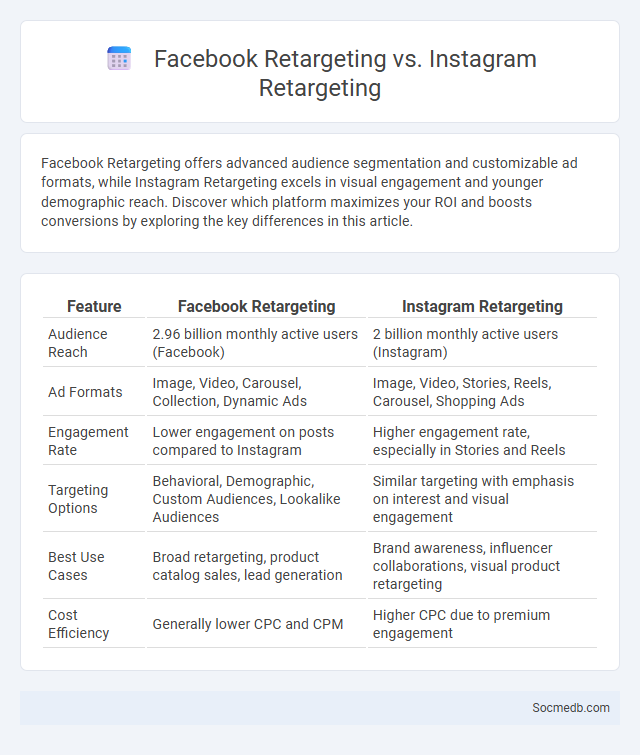
Photo illustration: Facebook Retargeting vs Instagram Retargeting
Facebook Retargeting offers advanced audience segmentation and customizable ad formats, while Instagram Retargeting excels in visual engagement and younger demographic reach. Discover which platform maximizes your ROI and boosts conversions by exploring the key differences in this article.
Table of Comparison
| Feature | Facebook Retargeting | Instagram Retargeting |
|---|---|---|
| Audience Reach | 2.96 billion monthly active users (Facebook) | 2 billion monthly active users (Instagram) |
| Ad Formats | Image, Video, Carousel, Collection, Dynamic Ads | Image, Video, Stories, Reels, Carousel, Shopping Ads |
| Engagement Rate | Lower engagement on posts compared to Instagram | Higher engagement rate, especially in Stories and Reels |
| Targeting Options | Behavioral, Demographic, Custom Audiences, Lookalike Audiences | Similar targeting with emphasis on interest and visual engagement |
| Best Use Cases | Broad retargeting, product catalog sales, lead generation | Brand awareness, influencer collaborations, visual product retargeting |
| Cost Efficiency | Generally lower CPC and CPM | Higher CPC due to premium engagement |
Understanding Retargeting: Core Concepts and Benefits
Retargeting on social media involves tracking your audience's interactions to deliver personalized ads that increase conversion rates and brand recall. By analyzing user behavior data, you can create targeted campaigns that re-engage potential customers who previously showed interest but did not complete a desired action. This strategy boosts ROI by narrowing ad spend to users most likely to convert, enhancing your advertising efficiency.
What Is Facebook Retargeting?
Facebook retargeting is a powerful advertising strategy that allows you to reconnect with users who have previously interacted with your website or app. By leveraging the Facebook Pixel, it tracks visitor behavior and delivers personalized ads to encourage conversions and boost engagement. This targeted approach enhances the effectiveness of your marketing campaigns by focusing on potential customers already familiar with your brand.
Key Features of Instagram Retargeting
Instagram retargeting leverages user data to serve personalized ads to individuals who have previously interacted with your profile or content, increasing conversion rates by targeting warm audiences. Key features include custom audience segmentation based on behaviors such as page visits, video views, and engagement, allowing you to tailor campaigns precisely. Leveraging dynamic ads and Instagram Stories retargeting further enhances user engagement by delivering relevant product recommendations and immersive content directly to your audience's feed.
Comparing Facebook Retargeting vs Instagram Retargeting
Facebook retargeting leverages its extensive user data across the entire Facebook ecosystem, allowing advertisers to target users based on detailed behaviors, interests, and interactions on both Facebook and associated platforms like Messenger and Audience Network. Instagram retargeting benefits from high engagement rates and visual-centric content, making it highly effective for brands aiming to reconnect with users through compelling images and video ads within the Instagram Feed, Stories, and Explore sections. Campaign performance often depends on audience demographics and content type; Facebook's broader reach suits diverse objectives, while Instagram excels in targeting younger, visual-driven audiences with immersive ad formats.
Audience Targeting Capabilities: Facebook vs Instagram
Facebook offers advanced audience targeting capabilities with options such as Custom Audiences, Lookalike Audiences, and detailed demographic, interest, and behavior filters, making it ideal for reaching highly specific user segments. Instagram, while integrated with Facebook's advertising platform, excels in targeting younger demographics and visual content consumers, leveraging engagement-driven algorithms to refine audience reach. Both platforms use Facebook Ads Manager for campaign creation, but Facebook's broader user data and diverse targeting tools provide greater precision for advertisers targeting niche markets.
Ad Formats: Differences Across Facebook and Instagram
Facebook offers diverse ad formats including carousel, video, slideshow, and lead ads, enabling detailed targeting and engagement options suited for broad audience segments. Instagram emphasizes visually-driven formats like Stories, Reels, and photo ads, prioritizing high-impact imagery and short-form video to capture younger, trend-focused users. Both platforms support shoppable posts and interactive ads, but Instagram's immersive visual approach contrasts with Facebook's varied format versatility.
Performance Metrics: Measuring Retargeting Success
Performance metrics such as click-through rates (CTR), conversion rates, and return on ad spend (ROAS) are critical in measuring retargeting success on social media platforms. Tracking user engagement and behavior through pixel data and audience segmentation allows you to optimize ad relevancy and increase campaign efficiency. Accurate measurement of these KPIs ensures your retargeting strategy drives higher ROI and sustained customer interaction.
Cost and ROI Analysis: Which Platform Performs Best?
Evaluating social media platforms based on cost and ROI analysis reveals significant differences in performance and expense efficiency. Platforms like Facebook and Instagram offer sophisticated targeting tools that can lower cost-per-click while delivering higher conversion rates, maximizing your advertising budget's effectiveness. Understanding your audience and campaign goals helps identify which platform yields the best return on investment for your social media marketing efforts.
Cross-Platform Retargeting Strategies
Cross-platform retargeting strategies enhance ad effectiveness by reaching users across multiple social media channels such as Facebook, Instagram, Twitter, and LinkedIn. Leveraging data from user interactions, businesses create personalized ad campaigns that improve conversion rates and maximize return on investment (ROI). Integrating tools like Facebook Pixel and Google Ads enables seamless tracking and dynamic ad delivery, optimizing audience engagement and driving sales growth.
Choosing the Right Retargeting Platform for Your Business
Choosing the right retargeting platform for your business involves analyzing audience demographics, ad formats, and integration capabilities with your existing marketing tools. Platforms like Facebook Ads, Google Ads, and LinkedIn Ads offer unique features tailored to different industries and customer behaviors, ensuring precise targeting and higher conversion rates. Maximizing your retargeting strategy requires selecting a platform that aligns with your specific business goals, budget, and customer engagement patterns.
 socmedb.com
socmedb.com